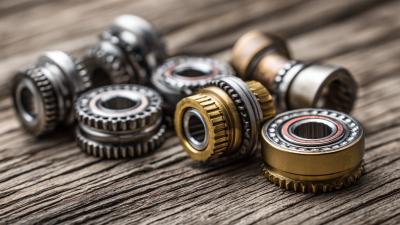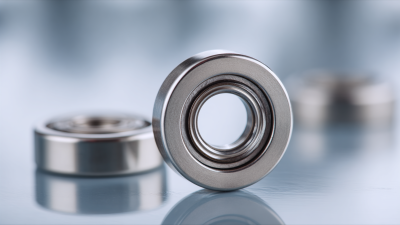Mastering Rotor Bearings: Innovative Solutions for Enhanced Performance and Longevity
Table of Contents
- Innovative Materials: Reducing Wear and Enhancing Rotor Bearing Lifespan
- Advanced Lubrication Techniques: Minimizing Friction and Heat Generation in Bearings
- Predictive Maintenance Strategies for Rotor Bearings to Boost Operational Efficiency
- Impact of Operating Conditions on Rotor Bearing Performance and Longevity
- Data-Driven Insights: Leveraging IoT for Optimal Bearing Management and Longevity
- FAQS
- Conclusion
- Related Posts
In the constantly changing world of engineering and machinery, the performance and lifespan of rotor bearings are pretty important when it comes to keeping stuff running smoothly.
 Shandong Hangshuo Bearing Co., Ltd., started back in 2015, and they've really been pushing the envelope when it comes to bearing tech. As a high-tech company that handles everything from
research and development to manufacturing and sales, they offer a wide range of bearings suited for all sorts of industries—think automotive, mining, construction, textiles, and farming machinery.
This article takes a closer look at some pretty cool solutions for mastering rotor bearings, especially focusing on innovative designs and new materials that boost both how well these bearings work and how long they last.
With the latest tech and a bunch of expertise under their belt, Shandong Hangshuo is dedicated to delivering top-notch rotor bearing solutions that meet the needs of modern machines and help promote more sustainable industries.
Shandong Hangshuo Bearing Co., Ltd., started back in 2015, and they've really been pushing the envelope when it comes to bearing tech. As a high-tech company that handles everything from
research and development to manufacturing and sales, they offer a wide range of bearings suited for all sorts of industries—think automotive, mining, construction, textiles, and farming machinery.
This article takes a closer look at some pretty cool solutions for mastering rotor bearings, especially focusing on innovative designs and new materials that boost both how well these bearings work and how long they last.
With the latest tech and a bunch of expertise under their belt, Shandong Hangshuo is dedicated to delivering top-notch rotor bearing solutions that meet the needs of modern machines and help promote more sustainable industries.
Innovative Materials: Reducing Wear and Enhancing Rotor Bearing Lifespan
You know, innovative materials are really making a big difference when it comes to boosting the performance and lifespan of rotor bearings, especially in tough environments like electric vehicles and aerospace. I’ve come across recent research that highlights how advanced coatings—like those made through high-speed laser cladding—are a game-changer. These coatings cut down on wear and tear quite a bit, so rotor bearings can handle more extreme conditions without giving up. For example, one study compared coated brake discs to traditional ones and found the coated versions last up to 30% longer. That’s a huge win because it means less maintenance and less downtime overall.
And it’s not just coatings—there’s also some exciting stuff happening with new rotor designs and materials. They’re showing real promise, especially in managing those crazy high temperatures without losing performance. One cool approach is using bend-twist-coupled designs in wind turbines—these not only help reduce wear but also extend the lifespan without adding more weight to the system. As more industries push for sustainability, fine-tuning both materials and designs is becoming more and more crucial to keep rotor bearings reliable and efficient. All these innovations are really paving the way for smarter, longer-lasting equipment that can handle the demands of today’s world.
Advanced Lubrication Techniques: Minimizing Friction and Heat Generation in Bearings
Getting lubrication right is honestly a big deal when you're trying to boost the performance and lifespan of rotor bearings. These days, more advanced lubrication methods are all about cutting down on friction and heat, because those two things really mess with how well and how reliably the bearings work. Manufacturers are now using synthetic lubricants with better formulations, which helps to lower friction and keeps everything running smoothly, even when under different loads.
On top of that, there are some pretty cool new ways to deliver the lubricant—like micro-lubrication systems and automatic lubrication schedules. These tools make sure the lubricant gets exactly where it’s needed, right on the contact points. Plus, they help keep the bearing’s temperature in check. The result? Bearings last longer, maintenance costs come down, and overall system performance gets a nice boost. It’s like giving your bearings a little extra attention that really pays off in the long run.
Predictive Maintenance Strategies for Rotor Bearings to Boost Operational Efficiency
Predictive maintenance for rotor bearings is honestly a game-changer when it comes to keeping industrial operations running smoothly. When companies use advanced monitoring tools, they can catch issues before they turn into big, costly failures. Stuff like vibration checks, thermal cameras, and sound monitoring are all pretty cool — they gather real-time info so maintenance teams can spot signs of wear or weird patterns early on. It’s all about being one step ahead, which means less unexpected downtime and, honestly, longer-lasting bearings because you jump in with repairs just in time.
And here’s the kicker: when you combine this with smart data analysis, it gets even better. Thanks to machine learning and historical data, companies can actually predict how equipment will perform in the future. This means maintenance isn’t just done on a schedule — it’s done when it really needs to be, based on real condition data. That way, you avoid unnecessary work and make sure the important stuff gets fixed exactly when it’s needed. In the end, this approach is all about making operations more efficient, saving money, and minimizing those frustrating production stoppages that caught everyone off guard.
Mastering Rotor Bearings: Innovative Solutions for Enhanced Performance and Longevity - Predictive Maintenance Strategies for Rotor Bearings to Boost Operational Efficiency
| Dimension | Value | Notes |
|---|---|---|
| Operating Temperature Range (°C) | -40 to 120 | Standard for most industrial applications |
| Load Rating (kN) | 50 - 150 | Depending on the bearing type |
| Lifespan (hours) | 15,000 - 30,000 | With optimal maintenance |
| Maintenance Interval (months) | 6 - 12 | Based on usage and conditions |
| Vibration Level (mm/s) | Acceptable level for reliability | |
| Lubrication Type | Grease | Recommended for high-load applications |
| Predictive Maintenance Tools | Temperature Sensors, Vibration Analysis | To monitor performance |
| Common Failure Modes | Wear, Corrosion, Grease Degradation | Regular checks can prevent failures |
Impact of Operating Conditions on Rotor Bearing Performance and Longevity
You know, the way rotor bearings perform and how long they last really depends a lot on their operating conditions. Lately, there's been some pretty cool advancements where folks are now integrating hybrid triboelectric-piezoelectric smart tech into rotor systems. Honestly, it’s a game-changer—these systems can now sense issues on their own and even power themselves up! That means they can monitor the bearing’s health in real-time, keeping everything running smoothly even when workloads fluctuate. Using these smart systems, potential problems can be spotted early on, which really helps boost the overall reliability and extend the life of the bearings.
On top of that, researchers are diving into new materials and advanced modeling techniques to get better performance, especially under elastohydrodynamic lubrication conditions. For example, analyzing gas film pressure in gas foil thrust bearings gives us a much clearer picture of what's happening during operation. All of this combined leads to smarter maintenance plans and better design improvements. In the end, these innovations make rotor bearings more robust, helping them stand up to all the tough conditions they face on the job.
Data-Driven Insights: Leveraging IoT for Optimal Bearing Management and Longevity
These days, when it comes to improving rotor bearing performance, a lot of the focus has shifted to data-driven insights, especially with the rise of the Internet of Things (IoT). Basically, by tapping into IoT tech, manufacturers can get real-time updates on bearing conditions. That means they can do maintenance before things even go wrong, which is pretty cool. This proactive approach not only helps bearings last longer but also boosts the overall efficiency of the machinery. Industries like automotive, mining, and engineering equipment really stand to gain from these improvements—more performance, less downtime, you know?
At Shandong Hangshuo Bearing Co., Ltd., we've been around since 2015, and we're all about bringing innovative solutions into our bearings. Our wide range of products is designed to meet the demands of fields like mining and farming equipment, where you really can't afford any failures. By embracing IoT strategies, we're able to offer our clients better management options that not only extend the life of our bearings but also help cut down operational costs. Staying ahead with these new technologies keeps us at the cutting edge of bearing innovation, helping us serve our customers’ changing needs more effectively.
FAQS
: Innovative materials significantly enhance rotor bearing performance and longevity, particularly in demanding applications like electric vehicles and aerospace, by reducing wear rates and enabling them to withstand harsher operating conditions.
Advanced coatings, such as those developed through high-speed laser cladding, can increase the lifespan of rotor bearings, with studies showing coated brake discs lasting up to 30% longer than traditional discs.
New rotor designs, such as bend-twist-coupled designs used in wind energy, help reduce wear and extend lifespan while maintaining performance and minimizing added weight.
Effective lubrication is crucial as it minimizes friction and heat generation, which are key factors affecting the efficiency and reliability of rotor bearings.
Advancements include the use of synthetic lubricants with superior formulations and innovative delivery methods like micro-lubrication systems that provide precise application of lubricants.
By reducing friction and improving bearing life, advanced lubrication techniques can lead to lower maintenance costs and enhanced overall system performance.
Synthetic lubricants can significantly lower friction coefficients, allowing for smoother operation of rotor bearings under various load conditions.
Automated lubrication schedules ensure that lubricants are applied consistently and adequately, maintaining optimal temperature levels within the bearings and improving their lifespan.
Optimizing materials and designs is essential for ensuring the reliability and efficiency of rotor bearings, particularly as industries transition towards more sustainable practices.
These innovations in lubrication and materials lead to enhanced performance, reduced maintenance needs, and better overall equipment effectiveness, contributing to advancements in various industries.
Conclusion
So, the article titled "Mastering Rotor Bearings: Innovative Solutions for Enhanced Performance and Longevity" dives into some pretty exciting advancements in rotor bearing tech — stuff that really helps make machines run smoother and last longer, you know? It talks about using new materials that cut down on wear and tear, which means the bearings stay in good shape for much longer. Plus, it highlights these cool, advanced lubrication techniques that reduce friction and heat, leading to better overall performance.
They also stress how important predictive maintenance is — kinda like staying ahead of potential issues before they happen. This way, you can extend the life of your rotor bearings and keep things running like clockwork. The article even explores how different operating conditions can affect performance, and how leveraging data from IoT devices can give you real-time insights to better manage those bearings.
And speaking of leading the charge, Shandong Hangshuo Bearing Co., Ltd. is in a great position to put these clever solutions to work across all sorts of industries — automotive, industrial machinery, you name it — to make rotor bearings tougher and more reliable overall.
Related Posts
-

The Ultimate Guide to Understanding Tapped Bearings and Their Applications in Engineering
-

How to Optimize Your Machinery with High Precision High Speed Bearings
-

7 Essential Features of Real Bearing That Set It Apart in the Market
-

Ultimate Guide to Selecting the Right Torrington Roller Bearing for Your Application
-

Exploring Unique Alternatives for Micro Miniature Bearings in Global Sourcing
-

Revolutionize Your Ride: The Ultimate Guide to High-Performance Tyre Bearings
Blog Tags:
